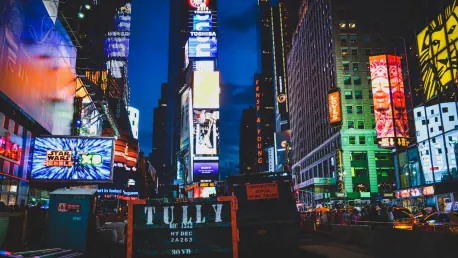The marketing landscape has evolved dramatically over the past decade, with an increasing focus on digital and social media platforms. Amid this digital revolution, one wonders: is the marketing industry underrating the power of out-of-home (OOH) advertising? Despite its historical roots and the revolutionary potential of digital formats, OOH continues to hold a significant place in the marketing mix. This article delves into the creative and commercial effectiveness of OOH advertising, shedding light on its often-overlooked value.
The Essence of OOH Advertising
Out-of-home (OOH) advertising includes a variety of media formats designed to reach consumers when they are outside their homes. Billboards, bus stops, subway ads, and interactive digital displays all fall under this category. As digital and social media marketing have gained prominence, OOH advertising has often been overshadowed. However, its unique ability to engage and create impact remains indispensable.
The Jaffa Cake campaign by TBWA is a compelling case study highlighting OOH’s effectiveness in long-term brand building. Assessed by System One, the campaign achieved a remarkable 4.9-star effectiveness score, outperforming comparable TV ads. This exemplifies how OOH can drive substantial commercial success when executed creatively.
Beyond its traditional formats, OOH advertising has embraced modern technologies like AI and CGI. The JD Sports Big Ben campaign offers a prime example, where an AI-generated ad went viral on social media. This raises a critical point about OOH’s viral potential, even as concerns about authenticity and trustworthiness persist.
Industry Leaders’ Perspectives
According to Ed Glover, Founding Partner and CEO of Recipe, traditional OOH remains incredibly effective due to its unavoidable presence and potential for creative innovation. From weather-reactive ads to interactive displays, OOH captivates audiences in ways digital ads often can’t.
Raquel Chicourel, CSO of TBWA\London, argues that OOH’s simplicity and cultural resonance make it a formidable tool in the marketing arsenal. When crafted with a media-agnostic perspective, OOH campaigns can rival or surpass traditional media in impact.
Zack Gardner, Copywriter at Collective, points out the industry’s preoccupation with ROI-driven metrics. This focus often sidelines OOH’s creative allure, yet notable campaigns continue to demonstrate its tangible results. The challenge lies in balancing creative expression with metrics.
James Clarke, Design Director of Bandstand, highlights the importance of minimalism and community integration in OOH campaigns. When ads are contextually grounded, they can seamlessly blend into environments, offering visual respite rather than intrusive noise.
Will Butler and Matt Adams, Creatives at Dark Horses, emphasize OOH’s shareability due to its simplicity and scale. By distilling messages into their most digestible forms, brands can make memorable statements that get shared widely.
Marie Le Hur, Marketing Director at Ocean Outdoor UK, notes a significant gap in budget allocations. Despite OOH’s effectiveness, it often receives less investment compared to performance marketing. She advocates for a balanced approach that leverages OOH’s unique strengths.
Cutting Through the Noise
OOH advertising excels at cutting through the noise, especially in today’s fragmented attention spans. A prime example is the Jaffa Cakes campaign. The clear, bold message “It’s a cake” resonated in busy public environments, proving that simplicity works best in OOH settings.
Sophisticated OOH campaigns, such as Recipe’s weather-reactive ads for Smart Water and 3D ads for New York Bakery Co., showcase the medium’s diverse possibilities. These creative approaches captivate audiences and drive engagement in ways digital ads struggle to match.
Integration between OOH and digital platforms can further amplify reach and impact. Social media snaps, shares, and user-generated content (UGC) can transform well-crafted OOH ads into viral phenomena. This interplay enhances overall campaign effectiveness.
Real-World Applications and Case Studies
Innovative use of OOH by Recipe, such as weather-reactive digital displays, shows the medium’s potential for real-time engagement. Similarly, anamorphic 3D ads for New York Bakery Co. captivate audiences by offering an immersive experience.
Collective’s Zipcar campaign demonstrates how innovative placements amplify reach. By wrapping a bus and translating traditional OOH into digital success, Zipcar significantly extended its advertising footprint, proving the flexibility of OOH formats.
Bandstand’s minimalist approach in the British Airways’ “A British Original” campaign shows how subtlety can foster community engagement. Contextually integrated OOH can enhance environmental aesthetics and become a beloved public staple.
Dark Horses’ interactive OOH ads for the AIG Women’s Open highlight the medium’s immersive capabilities. By creating playable ads, OOH offers unique interaction opportunities, deepening audience engagement.
Budget Reallocation for Maximum Impact
The marketing landscape has undergone a significant transformation over the past ten years, primarily driven by the rise of digital and social media platforms. With this digital revolution taking center stage, it’s worth considering whether the marketing industry is undervaluing the influence of out-of-home (OOH) advertising. Although rooted in history, OOH advertising remains a vital component of the marketing strategy, even amidst the surge of digital formats.
Conclusion
This article explores the creative and commercial impact of OOH advertising, emphasizing its often-overlooked significance. In an era dominated by screens and online interactions, OOH offers a refreshing and tangible way to engage consumers. Billboards, transit ads, and outdoor posters break through the digital noise, offering brand messages that can’t be skipped or blocked. These formats can target a diverse audience in public spaces, creating a memorable impression that digital ads sometimes fail to achieve.
Furthermore, innovations within OOH, like digital billboards and augmented reality interactions, blend traditional approaches with modern technology, enhancing their appeal. Through these methods, brands can deliver dynamic and contextually relevant content, improving engagement and recall. In conclusion, while the digital realm continues to expand, the staying power of OOH advertising shouldn’t be underestimated, as it continues to play a crucial role in comprehensive marketing strategies.









